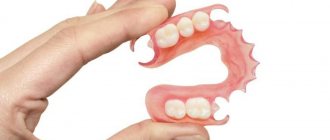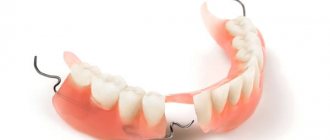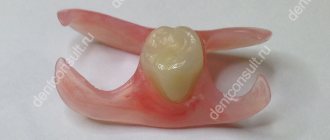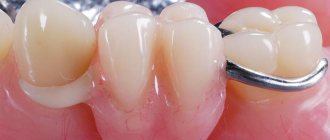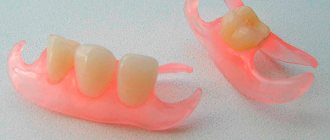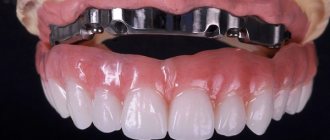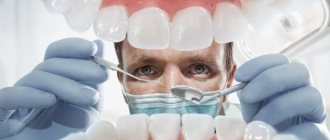How a partial denture is attached to the jaw
There are 3 options for fastening removable structures: hooks (clasps), locks (attachments), telescopic crowns.
We propose to consider each of the options in more detail. Clasps. They are hooks made of metal or plastic that grip healthy teeth and fix the orthopedic structure in the mouth. The disadvantage of such fastening is poor fixation and unsatisfactory aesthetics. Despite the fact that the hooks are covered by the lip, they are visible to others when smiling and talking.
Attachments. More preferable from an aesthetic point of view. The special lock consists of 2 parts. One element is built into the base of the prosthesis, and the other is attached to the crown that covers your own tooth. This fastening option has a more reliable fixation and gives the product stability. In addition, the attachments distribute the chewing load more evenly, which slows down bone atrophy by almost 2 times.
Telescopic crowns. Presented by a system consisting of 2 crowns. The inner one follows the contours of the ground tooth. The outer one is connected to the base and restores the shape of the tooth. This allows the prosthesis to be securely fixed and prevents it from moving. The possibility of installing a telescopic structure in each specific case is determined by the doctor, since grinding of a large layer of hard tissue of the supporting tooth is required.
General information about the prosthesis
A removable plate prosthesis is a covering orthopedic structure that restores any number of extracted teeth and is based on a base plate made of artificial material. As a rule, when people talk about such a design, they imagine the classic “removable jaw” with an overlapping palate and massive pink gums. This idea is correct (although the species may differ slightly), because. here the main determining factor is the massiveness of the prosthesis, most of which resembles a solid plate - an imitation of ordinary gums and palate. And the rest is artificial crowns made of plastic or ceramics and fastening elements made of synthetic polymers or metal. Such products require careful care; they must be removed after each meal and washed.
The picture shows an acrylic prosthesis - it is a plate prosthesis in the traditional sense (there are other types, but more on that later). Chewing pressure in plate models is transmitted mainly only to the mucous membranes, i.e. on the gums - and this happens unevenly.
And such designs as clasp, Quattro Ti (“Quadrotti”), sandwich dentures, and especially dentures on implants cannot be called removable plate ones, even if they have artificial gums. The fact is that these models, firstly, have more compact sizes - a reduced palate or palatal bridge, small areas of artificial gum. Secondly, their chewing pressure is more evenly distributed over the base, supports (teeth or implants) and gums - i.e. the mucous membranes are less overloaded or not overloaded at all. And, thirdly, they are considered conditionally removable – i.e. It is not necessary to remove them after every meal.
Indications and contraindications for use
Partial removable dentures are used in cases where the jaw is missing only a few teeth, but there are own healthy teeth that will be used as supporting teeth. Suitable for restoring both chewing and front teeth. The use of removable partial dentures is recommended in the following cases:
- missing several teeth;
- end defects of the jaw;
- atrophied bone tissue;
- the need for temporary prosthetics;
- contraindications to the installation of implants.
There are practically no contraindications to this type of prosthetics, and they are all temporary. These include viral diseases, carious lesions of teeth and periodontal tissue diseases.
Stages of manufacturing a removable partial denture
Depending on the type of prosthesis, the course of orthopedic treatment may differ slightly, but, in general, prosthetics can be divided into several main stages:
Preparation. After examination and diagnosis, the orthopedic doctor draws up a treatment plan and helps with choosing the optimal design option suitable for your particular case. At this stage, the oral cavity is sanitized. If necessary, teeth that cannot be saved are removed.
Taking impressions. Using impression material and a custom tray, the specialist takes impressions of the teeth on both jaws.
Manufacturing of the structure. In the dental laboratory, wax models are cast from the impressions, from which the technician makes the dentures.
Fitting and fixation. At the last visit, the doctor tries on the structure and fixes it in the oral cavity. If necessary, the prosthesis is adjusted and polished according to the bite.
Lifespan of removable partial dentures
Practice shows that the service life of removable plate structures is on average 3-5 years, after which the structure has to be changed. Bugel products have a longer lifespan - up to 5-7 years.
In general, the duration of wearing depends on several factors:
— the quality of the design and the professionalism of the specialist who carried out the installation;
— characteristics of the body and the condition of the oral cavity, the presence of gum diseases and deformation of the dentition;
— accuracy of compliance with doctor’s recommendations and proper home care.
General advantages and disadvantages
Plate dentures have disadvantages and advantages. Among the common disadvantages, one can highlight the significant discomfort that a person experiences when wearing them. Such products are not very convenient; they can accidentally fall out of the mouth. In addition, they look artificial, meaning almost everyone can notice their presence.
Important disadvantages of plate products:
- fragility - they cannot withstand heavy loads, an accidental fracture may occur, requiring the manufacture of a new structure;
- short service life - such a prosthesis will last no more than 5 years, while modern designs can last for decades;
- difficulty in getting used to - a foreign body in the mouth causes discomfort for a long time, salivation may increase, and a gag reflex is also often observed;
- uneven load distribution - the bone gradually decreases in volume and atrophies, which does not happen when fixed to implants.
Among the advantages we can highlight the ease of manufacture, which is why it is cheap and accessible to everyone. This is the most affordable option for prosthetics, which is why many patients still resort to it.
The advantage will be the restoration of chewing function. It cannot be said that such products completely compensate for chewing ability, but thanks to them a person can chew food normally. Modern variations of plate dentures have an acceptable appearance, the base matches the gum in color.
Rules for wearing and caring for prostheses
The first time after installation, removable dentures can cause discomfort. As a rule, it goes away by the end of the first week. In some cases, especially when using plate structures, addiction can last up to 3 weeks.
To speed up adaptation, there are general rules and recommendations: rinse your mouth with warm water more often, do not overload the denture with solid food for the first 3-4 days.
Carefully monitor hygiene, rinse your mouth after every meal, and beware of excessive chewing loads. For cleaning, you should not use abrasive cleaners; give preference to special solutions and pastes.
Are partial dentures repairable?
During use, individual parts of the prosthesis may break off. Under no circumstances should you attempt to repair it yourself; it is better to contact a specialist. If the situation can be corrected, it will only take a couple of days to fix it.
Every six months to a year, during a scheduled visit to the dentist, it is necessary to reline the plate and clasp structures, since the contour of the gums and the level of bone tissue change over time. The adjustment improves fit and load distribution, resulting in the product not chafing or breaking.
Is it possible to repair plate dentures?
Repairing removable plate dentures is possible, but not always. It all depends on the nature of the breakdown and the material from which the structure is made. For example, if a small chip has formed on it, a crack has appeared along the middle line of the base, and one of the fastening elements (hooks) has deteriorated, then it can be restored. Especially if it is made of acrylic. If the structure is made of nylon, then specialists most often do not undertake to restore it even if there are minor defects.
If the patient completely breaks the product due to the fact that he became interested in biting into foods that are prohibitively hard in such a situation (nuts, whole vegetables and fruits) or because it simply fell to the floor, then doctors most often in such a situation suggest replacing him for a new one.
It is believed that acrylic systems are very wear-resistant, but researchers have found that the number of certain breakdowns already in the first year of their operation reaches about 15%1, and repeated breakdowns in the vast majority of cases occur in the old place due to rapid wear of materials or poor-quality initial repair.
On a note! When operating plate structures, it is impossible to do without dietary restrictions. To ensure that they last longer and do not deform prematurely, do not consume viscous, viscous, loose or hard foods. To prevent cracks from appearing on artificial materials, you should not expose them to sudden temperature changes, eat foods that are too hot or too cold - food and drinks should be warm. Also, do not forget to limit the consumption of “colored” dishes with dyes, because... materials (acrylic, nylon, and polyurethane) absorb coloring pigments, which is why your artificial teeth may not change for the better.
The most frequently asked questions about partial dentures
Is an allergy possible? How long does it take to get used to? Do you need fixing gels when wearing? You can find out the answers to these and other most popular questions in this section of the article.
— Is it possible to have an allergic reaction?
Is it possible. As a rule, an allergy can occur to acrylic when wearing plate dentures. Or on metal if wearing a clasp design. Before installing a prosthesis, a doctor may recommend that particularly sensitive people undergo a special test for sensitivity to materials.
— How long does it take to get used to it?
Sometimes it can take up to 3-4 weeks to get used to it. This usually applies to plate dentures, since they are more noticeable in the oral cavity. Clasp designs do not require so much time.
— Do I need to use fixing gels when wearing partial structures?
Partial structures do not require additional fixation, since they already have fastenings (hooks or clasps).
— Do I need to take off my dentures at night?
It is not at all necessary to remove the structure at night. It is not even recommended to remove the prosthesis for the first 3-4 weeks after installation, since there is an adaptation period. Further, at the discretion of the patient.
— Are there any restrictions when wearing?
Avoid eating excessively hard foods such as nuts or ice. It is also not recommended to eat foods that are too viscous and stick to artificial teeth.
Full removable design
Plate dentures in the absence of teeth are called complete. They are larger in size and weight, and are attached by suction to the gums and using a special cream.
The complete design has a large base (dentures for the lower jaw are slightly smaller in size) for a tight fit to the mucous membrane and reliable fixation.
They can be fixed in several ways:
- suction cups - when installed on the upper jaw, they are an additional element of fixation;
- implants - when pins have been previously implanted, they can be used to fix removable and non-removable structures;
- clasps and hooks - this option is only possible if several teeth are preserved.
Complete dentures for the upper jaw usually cover the entire roof of the mouth. This has a bad effect on habituation, diction and taste. But there are also modern options for plastic structures that leave the sky open.
Partial dentures - reviews from specialists and patient opinions
In general, reviews of removable dentures from patients and doctors are positive. If there are contraindications to the installation of fixed structures, removable prosthetics are the only treatment option.
However, experts are confident that if there are no restrictions on implantation, the choice should be opted for prosthetics on implants. This option is the most preferable in terms of longevity, aesthetics, safety and prevention of bone atrophy.
What is the cost of a partial denture?
First of all, the price varies depending on the type of prosthesis and the number of lost teeth. Many are sure that a high-quality prosthesis cannot be very cheap. So what does its cost consist of?
The material of construction plays a big role in pricing. Modern dental clinics work with proven compounds for the manufacture of structures. This guarantees the quality, aesthetics and durability of the product.
All designs are made individually, based on the characteristics of the jaw structure, patient preferences and doctor’s recommendations.
Professionalism of staff and technical equipment. The experience of an orthopedist and dental technician, as well as high-tech equipment, is very important, so the price tag also adds up in terms of costs.
Prices
| Service | Price |
| Removable acrylic (plate) dentures | from 15,200 rub. |
| Taking a two-layer impression | from 900 rub. |
| Taking an alginate impression | from 500 rub. |
| Restoration of a removable denture | from 3500 rub. |
To avoid possible misunderstandings, please clarify the cost of services in clinics with the administrator or during a consultation with a doctor. Prices on the website are not a public offer.
Sign up for a consultation
Where in Voronezh can a partial removable denture be installed?
For a quality result, it is important to choose a dental clinic and attending physician wisely. Making the wrong choice can create a lot of problems and cost you a lot of time and money to fix the mistake. Be sure to pay attention to the specialist’s experience, the availability of modern equipment and reviews of other patients.
You can install partial removable dentures in Voronezh at. We offer production using modern equipment, high-quality materials and competitive prices. Our consummate specialists are always ready to help. We are waiting for you for your first free consultation!
Expert opinion
Despite all the positive possibilities and nuances of using prosthetic structures, this is the optimal solution for replacing missing teeth on a limited budget. With such a prosthesis, it is possible to smile, chew food, and talk freely.
The 32 Dent clinic specializes in installing removable dentures for patients, including plate dentures made of plastic, nylon, and ceramic crowns. Sign up for a free consultation with a dentist or prosthetist who will expertly perform jaw prosthetic work.
If you have a problem similar to that described in this article, be sure to contact our specialists. Don't diagnose yourself!
Why you should call us now:
- We will answer all your questions in 3 minutes
- Free consultation
- The average work experience of doctors is 12 years
- Convenient location of clinics
Single contact phone number: +7
Make an appointment
Sources:
- Personal experience as an orthopedic dentist;
- Abdurakhmanov, A. I. Materials and technologies in orthopedic dentistry. Textbook / A.I. Abdurakhmanov, O.R. Kurbanov. - M.: Medicine, 2002;
- Mirgazizova, M.Z. Orthopedic dentistry / Edited by V.N. Kopeikina, M.Z. Mirgazizova. - M.: Medicine, 2001;
- Trezubov, V.N. Orthopedic dentistry. Applied materials science / V.N. Trezubov, M.Z. Shteyngart. - M.: St. Petersburg: SpetsLit; 3rd edition, 2003;
- Lebedenko I.Yu., Kalamkarova S.Kh. Orthopedic dentistry: diagnostic and treatment algorithms. - M.: Medical Information Agency, 2008;
- Ronauk, SinghTapan Singh and Jatinder Pal Singh Maxillofacial Materials – Then And Now / Ronauk Singh, Tapan Singh and Jatinder Pal Singh. - M.: LAP Lambert Academic Publishing, 2014;
- Arnold Hohmann - Principles of Design and Fabrication in Prosthodontics (2016);
- Guide to prosthetic dentistry. Prosthetics in the absence of teeth / ed. I.Yu. Lebedenko, E.S. Kalivradzhiyan, T.I. Ibragimova, E.A. Bra-gina. - M.: Medical Press LLC, 2008;
- Trezubov V.N., Mishnev L.M., Neznanova N.Yu. [and etc.]. Orthopedic dentistry. Technology of therapeutic and preventive devices. - St. Petersburg: SpetsLit, 2002.
